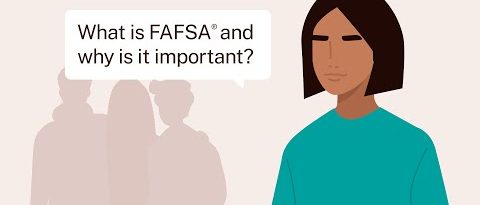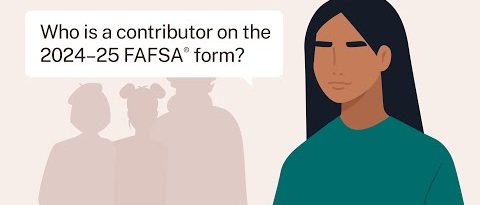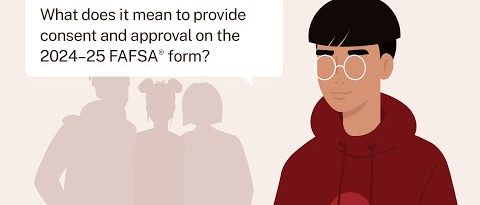Changes Coming to the 2024-2025 FAFSA
The FAFSA Simplification Act was passed by Congress in 2020 and marks a significant overhaul of the processes and systems used to award federal student aid. Included in the overhaul are changes to the Free Application for Federal Student Aid (FAFSA) form as well as the need analysis formulas that determine federal aid eligibility. There are also changes to terminology and policies and procedure changes for institutions that participate in federal student aid programs.
The 2024-2025 FAFSA will be available sometime in December 2023
Historically, the FAFSA application has been available effective October 1st each year. Due to the significant changes to the FAFSA and the FAFSA processing system, the 2024-2025 FAFSA will not be available until sometime in December 2023. Monitor studentaid.gov for updates to the FAFSA release.
You can use the Aid Estimator Tool to see an estimate of how much aid you may be eligible for. Note: this does not replace the FAFSA and is only meant to be a tool for students and families to better understand their options for paying for college.
UConn's on-time application deadline has changed for the 2024-2025 year. In order to be considered for most forms of UConn financial assistance, applications must now be received by March 15th, 2024.
Fewer Questions on the FAFSA
The maximum number of questions on the 2024-2025 FAFSA Application will be 46, down from 108 in 2023-2024. The streamlined format should simplify the application process for students and families.
The IRS Direct Data Exchange
In prior years, students and parents had the option to either enter their tax return information manually or to use the IRS Data Retrieval Tool. Beginning in 2024-2025, students (and parent(s) of dependent students, or spouses of independent students) must provide consent for the U.S. Department of Education to receive tax return information or confirmation of non-filer status directly from the IRS. Once consent is provided, information from the tax return will be automatically added to the FAFSA application.
All Contributors Must Provide Financial Information
A contributor is anyone who is required to provide information on the FAFSA application (such as a parent, stepparent, or student's spouse). A student's answers on the FAFSA will determine which contributors (if any) will be required to provide financial information.
Anyone identified as a contributor will receive an email informing them that they have been identified as such. They will need to log in using their own FSA ID (not the student's) to provide consent to access their financial information and transfer it to the FAFSA application. An FSA ID is required to access the FAFSA.
Note: contributors are not responsible for the student's educational costs, but must provide financial information on the FAFSA in order for the student to be eligible for federal student aid.
The Student Aid Index (SAI) is Replacing the Expected Family Contribution (EFC)
The Student Aid Index (SAI) will now be the number generated after the FAFSA is completed, and used by the financial aid office to determine financial aid offers.
One of the most notable changes to occur is that the minimum SAI will be -1500, a change from the minimum EFC of 0.
The need analysis formula behind the SAI is also changing. One of the largest changes is that while the number in college will still be listed as a question on the FAFSA, it will no longer be taken into consideration in the need analysis formula.
The need calculation used by UConn's Office of Student Financial Aid Services will remain the same, and looks like:
Cost of Attendance (COA) - SAI - OFA (Other Financial Assistance) = Financial Need
Automatic Maximum Pell Grant Eligibility for Some Students
Dependedent students meeting one of the situations below will qualify for the maximum Federal Pell Grant:
- The student's parent(s) are not required to file a federal income tax return;
- Families with an adjusted gross income less than or equal to 175% of the federal poverty level;
- Single parents with an adjusted gross income less than or equal to 225% of the federal poverty level
Independent students meeting one of the situations below will qualify for the maximum Federal Pell Grant:
- The student (and spouse, if applicable) are not required to file a federal tax return;
- The student is a single parent and has an adjusted gross income less than or equal to 225% of the federal poverty level;
- The student is not a single parent and has an adjusted gross income less than or equal to 175% of the federal poverty level
Federal Pell Grants for students that do not fall into the situations mentioned above will be determined by the student's SAI. To qualify in this case, the student's SAI will need to be less than the maximum Federal Pell Grant amount for the award year.
Parent Responsibility in Cases of Divorce
For dependent students, parental information previously came from the parent(s) the student lived with for the majority of the previous twelve months. Beginning with the 2024-2025 FAFSA application, financial information will be required from the parent(s) who provided the most financial support to the student in the previous twelve months. The FAFSA will contain a parent/contributor wizard to help students determine which parent(s) to include.
Changes to Asset Reporting
Families must now report the value of small businesses (regardless of number of employees) and family farms.





